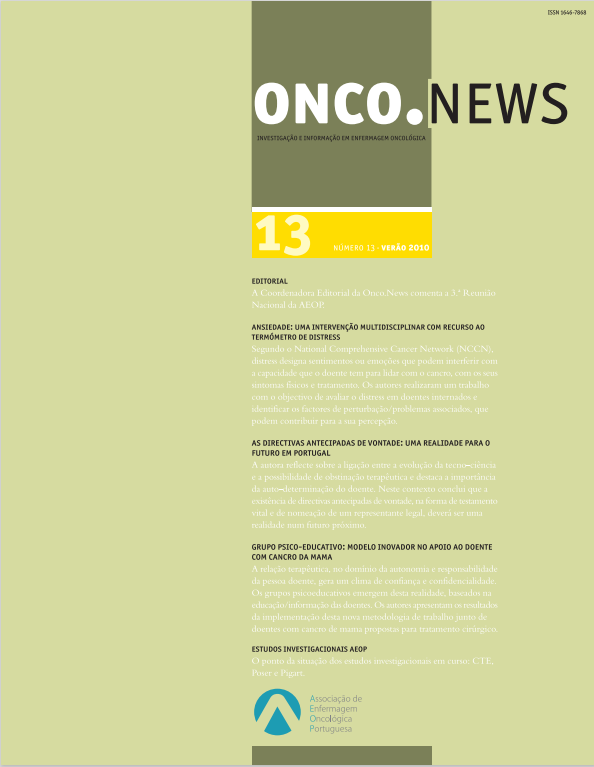Anxiety: a multidisciplinary intervention using the distress thermometer
DOI:
https://doi.org/10.31877/on.2010.13.01Keywords:
Distress, distress thermometer, oncology, head and neck cancerAbstract
According to the National Comprehensive Cancer Network (NCCN), distress is used to describe feelings or emotions that can interfere with the patient’s ability to deal with cancer, with their physical symptoms and treatment. This research was developed with two main objectives: to assess distress in patients admitted at the surgical department of head and neck of the IPO of Coimbra and identify stressors/problems associated with that may contribute to distress.
This study is a quantitative research with descriptive and exploratory characteristics. The sample consisted of 32 patients. The instruments used for collecting data were a socio-demographic questionnaire, the distress thermometer and the questionnaire for the identification of associated problems.
The level of distress reported by patients on admission was mostly “5” (moderate), and it decreased during the time spent in the hospital to a level of “2” at the time of discharge.
Downloads
References
HAYNAL, A.(1997) – A European View: A Meeting of Minds: Mutuality in Psychoanalysis by Lewis Aron (Hillsdale, NJ: The
Analytic Press, 1996). Psychoanal Dial, 7:881-884.
JEKEL JF, ELMORE JG, KATZ DL (1999) – Introdução à medicina preventiva. Porto Alegre: Artes Médicas Sul, p. 203-9.
LONG, B.(1999) – “Enfermagem Pré-Operatória”, In: PHIPPS, W. et al. – Enfermagem Médico-Cirúrgica: Conceitos e Prática Clínica, 4ª
ed., Lisboa, Lusodidacta, p. 430-458.
MADEN, J.(2006) – The problem of Distressin Patients with Cancer: More Effective Assessment. Clin J Oncol Nurs, 10(5):615-9.
MELEIS, AI, et al.(2000) – Experiencing transitions: an emerging middle-range theory. ANS Adv Nurs Sci, 23(1):12-28.
National Comprehensive Cancer Network (1999): NCCN practice guidelinesfor the management of psychosocial distress. Oncology,
:113-147.
POTASH M, Breitbart W.(2002) – Affective disordersin advanced cancer. Hematology Oncology Clinic North American, 16(3):671-
ZABORA J, et al.(2001) – A new psychosocialscreening instrument for use with câncer patients. Psychosomatics, 42(3):241-6.
SANTOS, J.(2008). Satisfação Profissional e Saúde. In: Psicologia da Saúde. São Paulo: Editora Metodista, p. 21-32.
Downloads
Published
How to Cite
Issue
Section
License
Copyright (c) 2023 Raquel Maria Soares Amado, Pedro Miguel Madaleno Cardoso, Jacinto Marques da Costa, Sandra Ferreira Santos, Ana Isabel Roque Martins, Rui Miguel Santos Pais, Joana Filipa Teixeira Ferreira

This work is licensed under a Creative Commons Attribution-NonCommercial-ShareAlike 4.0 International License.




